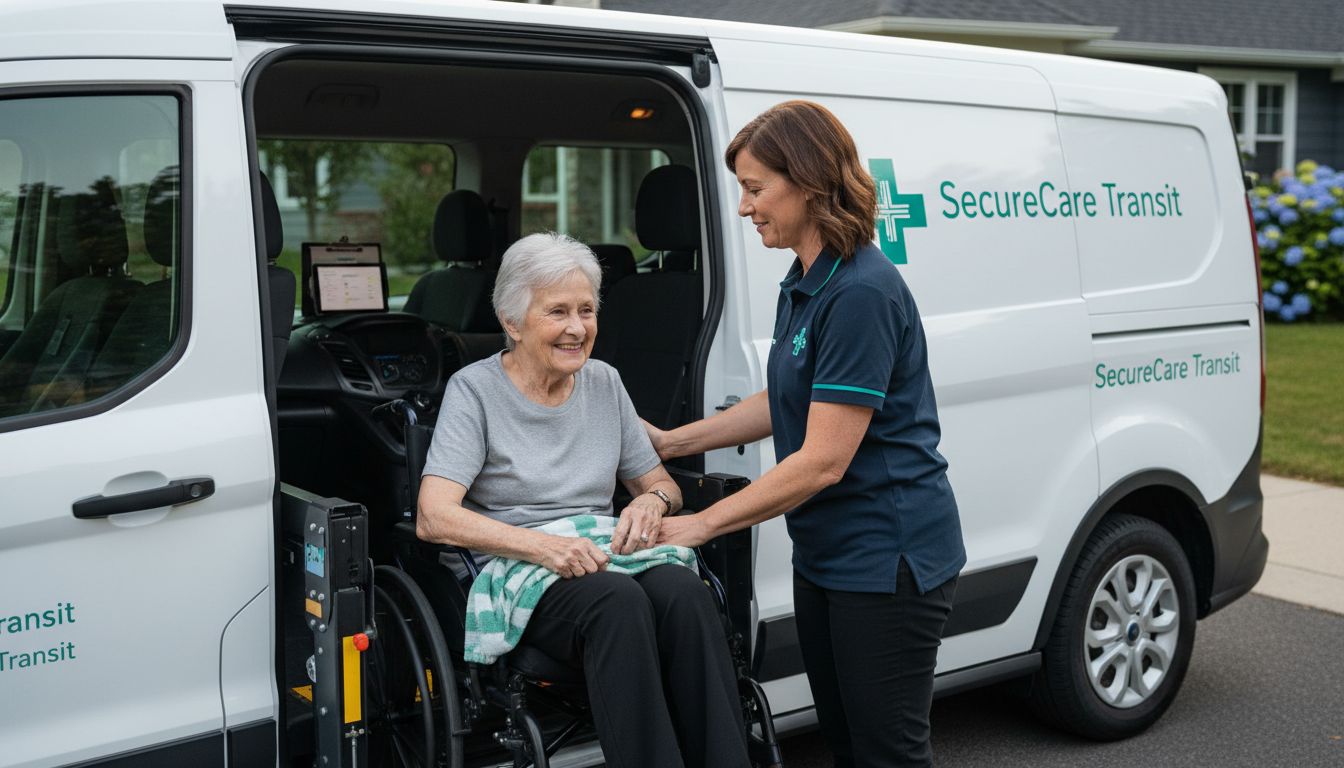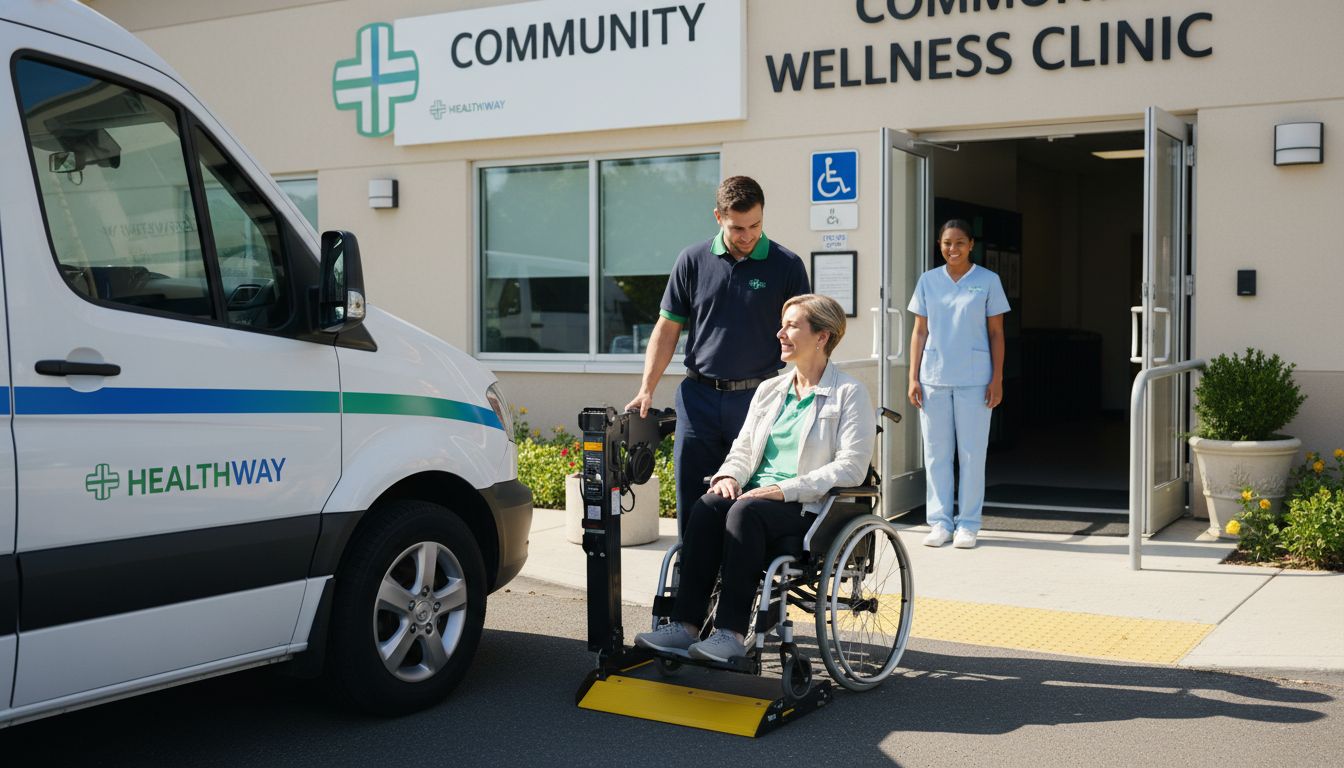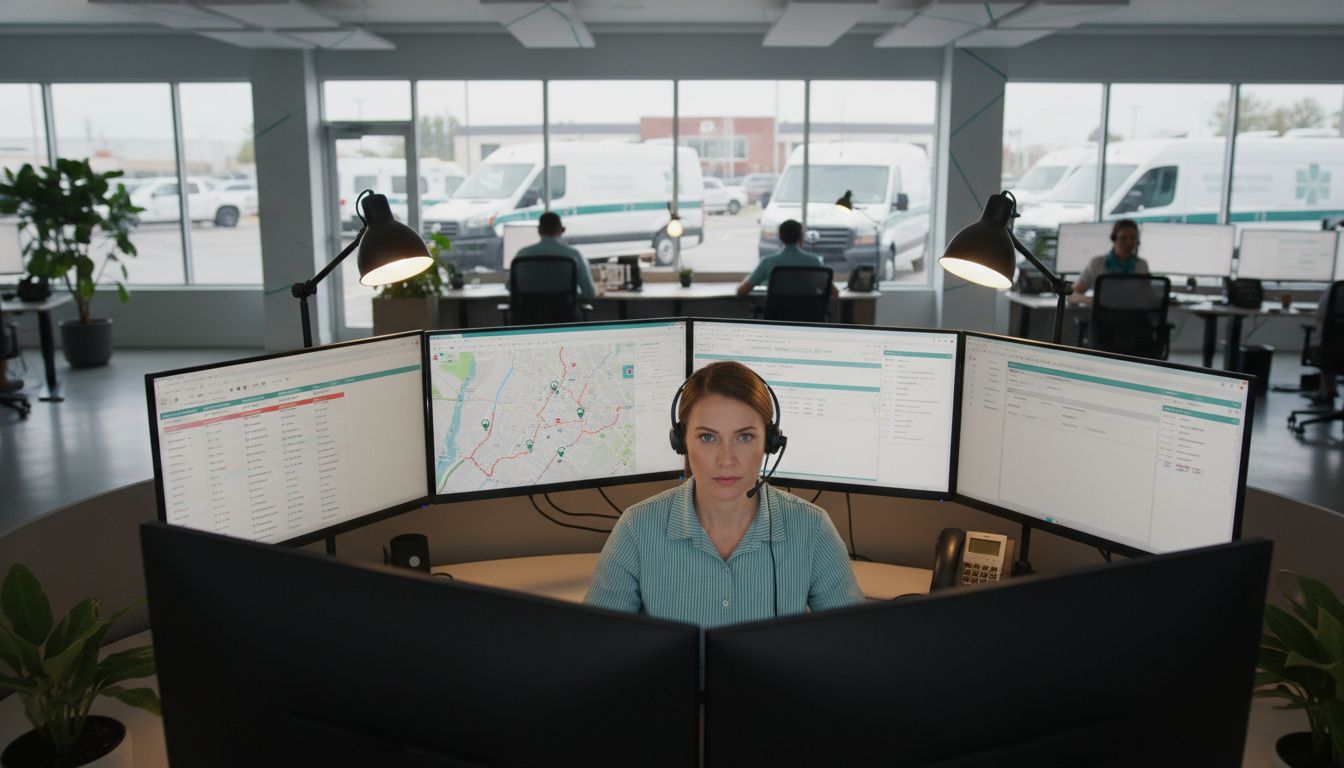Understanding Non Emergency Medical Services: A Comprehensive Guide
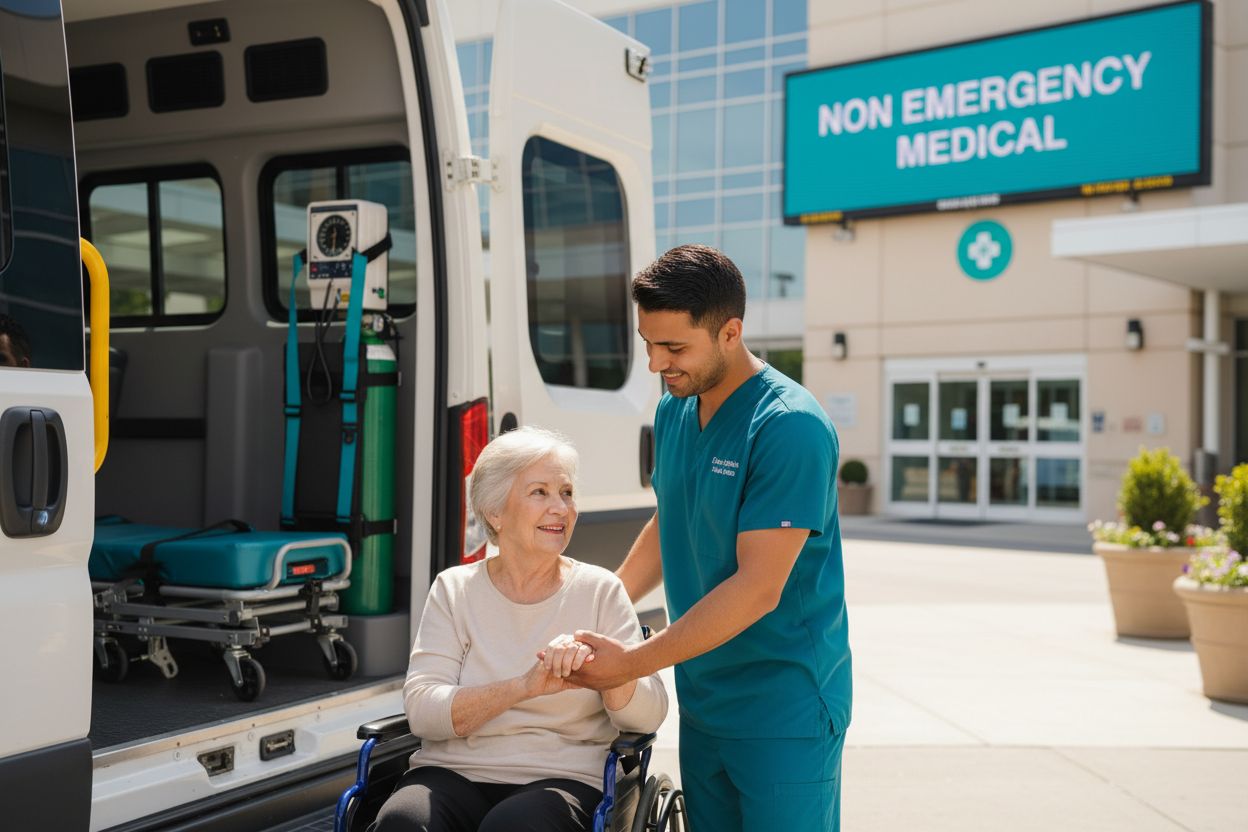
Non emergency medical services are quietly shaping patient care in ways most people never notice. Over 3.6 million Americans rely on non emergency medical transport every year to reach routine appointments and treatments. Surprising, right? It might sound like a simple shuttle service but these operations use sophisticated medical teams, custom vehicles, and advanced tech to keep vulnerable patients safe and the whole healthcare system running smoothly.
Table of Contents
- Defining Non Emergency Medical Services And Their Role
- Importance Of Non Emergency Medical Services In Healthcare
- How Non Emergency Medical Services Operate Mechanically And Logistically
- Key Concepts And Models In Non Emergency Medical Services
- Challenges And Innovations In Non Emergency Medical Services
Quick Summary
| Takeaway | Explanation |
|---|---|
| Non Emergency Medical Services bridge healthcare gaps. | NEMS improve access to medical services for patients unable to use traditional transport options. |
| NEMS enhance healthcare system efficiency. | They reduce unnecessary emergency room visits and manage patient transportation needs effectively. |
| Specialized vehicles and trained personnel are essential. | NEMS use tailored vehicles and staff trained to support patients’ medical and mobility needs during transport. |
| Innovative technology improves transportation logistics. | Advanced scheduling and tracking systems enable better coordination and efficiency in patient transport services. |
| Support for vulnerable populations is crucial. | NEMS provide necessary access to care for individuals with chronic conditions, disabilities, or those needing regular treatments. |
Defining Non Emergency Medical Services and Their Role
Non Emergency Medical Services (NEMS) represent a critical component of healthcare transportation that addresses the complex needs of patients requiring medical support without facing immediate life-threatening conditions. These specialized services provide essential medical transport for individuals whose healthcare requirements extend beyond traditional emergency responses.
The Fundamental Purpose of Non Emergency Medical Services
Non Emergency Medical Services focus on delivering structured, planned medical transportation for patients with stable medical conditions. Their primary objectives include:
- Facilitating scheduled medical appointments and treatments
- Supporting patients with limited mobility or chronic health conditions
- Ensuring safe and comfortable transportation between healthcare facilities
These services bridge crucial gaps in healthcare accessibility, particularly for vulnerable populations who might otherwise struggle to receive consistent medical care. Our comprehensive guide on patient transportation provides deeper insights into these critical support systems.
Characteristics and Operational Framework
Unlike emergency medical services that respond to urgent, life-threatening situations, NEMS operate with a more methodical and pre-planned approach.
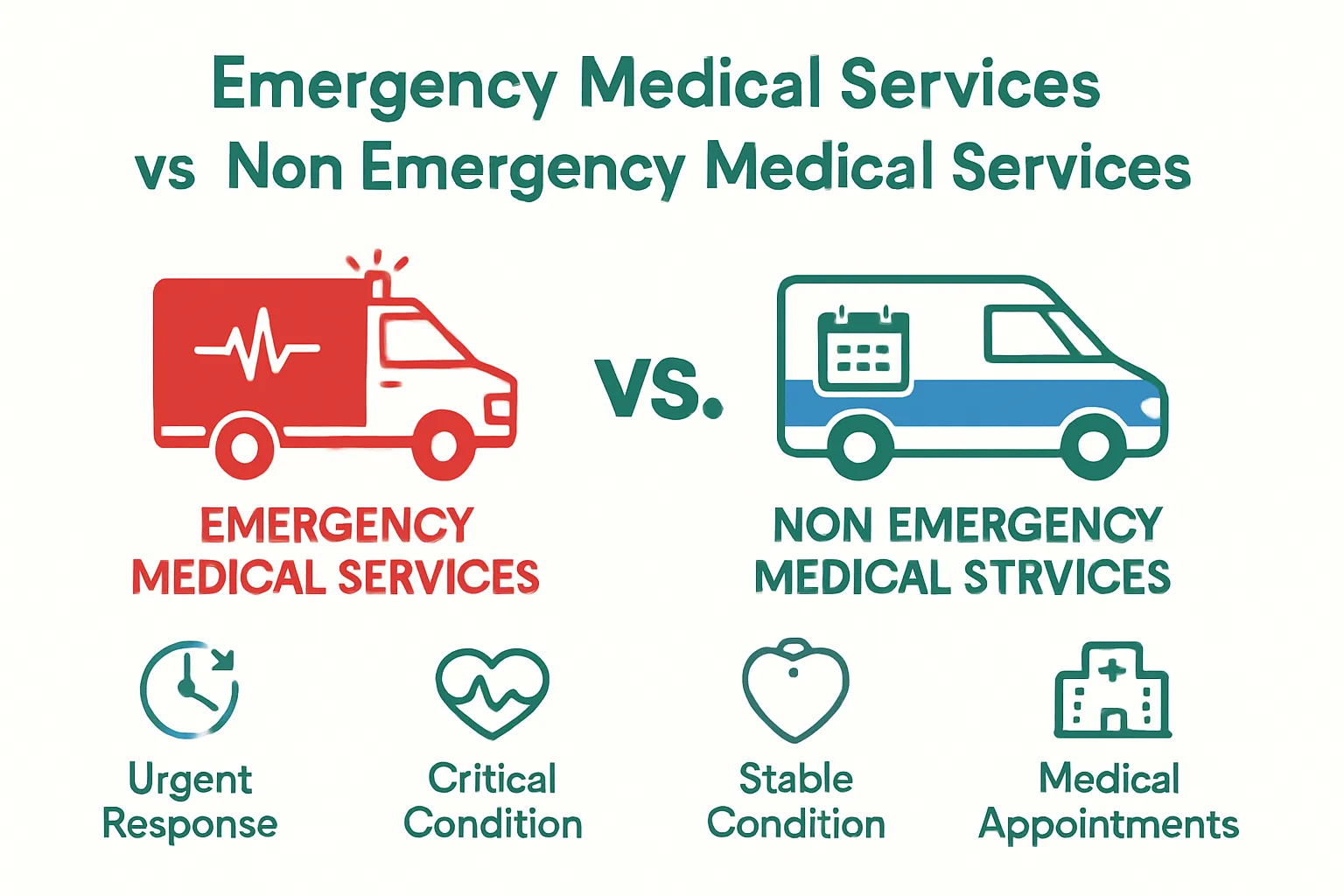
Trained medical professionals assess patient needs, determine appropriate transportation methods, and coordinate logistics to ensure safe and efficient transfers.
Key operational characteristics include:
- Specialized vehicles equipped with medical monitoring equipment
- Trained medical personnel capable of providing basic medical support
- Customized transportation solutions based on individual patient requirements
The strategic implementation of Non Emergency Medical Services ultimately reduces strain on emergency response systems, optimizes healthcare resource allocation, and ensures patients receive timely, appropriate medical attention through carefully managed transportation networks.
To help clarify the main differences between emergency and non emergency medical services, the table below contrasts their purposes, approaches, and typical patients.
| Aspect | Emergency Medical Services (EMS) | Non Emergency Medical Services (NEMS) |
|---|---|---|
| Primary Purpose | Immediate response to life-threatening emergencies | Scheduled transportation for stable patients |
| Response Time | Rapid, urgent | Pre-planned, scheduled |
| Patient Condition | Critical, unstable | Stable, chronic, or mobility-limited |
| Vehicle Equipment | Advanced life support, emergency gear | Mobility aids, medical monitoring |
| Personnel | Paramedics, EMTs | Medical technicians, trained drivers |
| Typical Scenarios | 911 calls, trauma, cardiac arrest | Dialysis visits, routine check-ups, rehab |
Importance of Non Emergency Medical Services in Healthcare
Non Emergency Medical Services (NEMS) play a transformative role in modern healthcare systems by addressing critical transportation challenges and improving patient access to medical care. Research indicates these services are instrumental in reducing unnecessary emergency department utilization and optimizing healthcare resource allocation.
Enhancing Healthcare System Efficiency
NEMS contribute significantly to healthcare system efficiency by preventing unnecessary emergency room visits and managing patient transportation for routine medical needs. Key efficiency benefits include:
- Reducing emergency department overcrowding
- Minimizing unnecessary ambulance deployments
- Providing cost-effective medical transportation solutions
Efficient patient transportation strategies help healthcare providers streamline their operations and allocate resources more effectively, ensuring patients receive timely and appropriate care.
Critical Support for Vulnerable Populations
Non Emergency Medical Services are particularly crucial for populations with limited mobility or complex medical requirements. These services ensure consistent medical care access for individuals who might otherwise struggle to attend routine appointments or receive necessary treatments.
Populations significantly benefiting from NEMS include:
- Elderly patients with chronic health conditions
- Individuals with disabilities
- Patients requiring regular dialysis or rehabilitation treatments
By providing specialized transportation solutions, NEMS help maintain continuity of care and prevent potential health complications arising from missed medical appointments or inadequate transportation support.
How Non Emergency Medical Services Operate Mechanically and Logistically
Modern medical transportation systems represent intricate networks of logistics, technology, and specialized healthcare transportation designed to meet diverse patient needs efficiently and safely. Non Emergency Medical Services operate through complex, carefully coordinated mechanisms that ensure reliable and appropriate medical transport.
Technological Infrastructure and Coordination
The operational framework of Non Emergency Medical Services relies heavily on advanced technological systems that enable seamless communication and scheduling. Key technological components include:
- Digital dispatch platforms for real-time vehicle tracking
- Patient medical record integration systems
- Automated scheduling and routing software
Fire and EMS logistics software plays a crucial role in optimizing these transportation networks, allowing for precise coordination and rapid response to patient transportation requirements.
Vehicle and Personnel Configuration
Non Emergency Medical Services maintain a diverse fleet of specialized vehicles equipped to handle various patient mobility and medical support needs. These vehicles are meticulously designed to accommodate different medical scenarios:
- Wheelchair accessible transportation
- Stretcher-compatible vehicles
- Advanced medical monitoring equipment installations
Personnel for these services are professionally trained healthcare workers who can provide basic medical monitoring, patient assistance, and ensure safe transportation. Their expertise ranges from certified medical technicians to drivers specifically trained in patient care and medical transport protocols.

The comprehensive approach of Non Emergency Medical Services transforms medical transportation from a simple logistical challenge into a sophisticated, patient-centered healthcare solution that prioritizes safety, efficiency, and individual patient needs.
Key Concepts and Models in Non Emergency Medical Services
Patient-centered medical transportation represents a sophisticated framework that goes beyond simple point-to-point movement, integrating complex medical, logistical, and human-centered considerations. Non Emergency Medical Services employ multiple conceptual models to ensure comprehensive and adaptive patient care.
Medical Necessity and Stratification Models
The fundamental approach of Non Emergency Medical Services revolves around medical necessity stratification, which determines the appropriate level of medical support and transportation required for each patient. This nuanced assessment considers multiple factors:
- Patient mobility status
- Medical equipment requirements
- Potential health risks during transportation
- Individual patient medical history
Innovative scheduling approaches for skilled nursing facilities demonstrate how these stratification models enable precise, customized transportation solutions that match specific patient needs.
Care Coordination and Interdisciplinary Approach
Non Emergency Medical Services operate through an interdisciplinary model that integrates inputs from various healthcare professionals. This collaborative approach ensures holistic patient transportation management:
- Physicians assess medical transport requirements
- Transportation specialists design optimal routing
- Nursing staff provide critical patient condition insights
- Technology platforms enable real-time communication
By synthesizing expertise from multiple domains, Non Emergency Medical Services create a comprehensive transportation ecosystem that prioritizes patient safety, comfort, and medical continuity.
Challenges and Innovations in Non Emergency Medical Services
Non Emergency Medical Services face complex challenges that demand continuous innovation and strategic technological interventions. The evolving healthcare transportation landscape requires adaptable solutions to address systemic limitations and emerging patient needs.
Systemic Challenges in Medical Transportation
The primary challenges confronting Non Emergency Medical Services encompass multifaceted operational and infrastructural barriers:
- Inconsistent regulatory frameworks across different regions
- Limited funding and resource allocation
- Geographic disparities in service accessibility
- Complex patient verification and eligibility processes
Technology solutions for resource management are increasingly becoming critical in addressing these fundamental challenges and creating more efficient transportation networks.
Technological Innovations and Strategic Responses
Healthcare transportation is experiencing a transformative period with technological innovations designed to overcome traditional limitations. Key strategic innovations include:
- Advanced digital scheduling platforms
- Real-time patient tracking systems
- Integrated telehealth pre-screening mechanisms
- Artificial intelligence routing optimization
These technological interventions aim to create more responsive, patient-centered transportation ecosystems that can dynamically adapt to changing healthcare requirements, ultimately improving service quality, reducing costs, and enhancing overall patient experience.
The following table summarizes the key challenges currently faced by Non Emergency Medical Services, alongside examples of technological innovations designed to address each challenge.
| Major Challenge | Example of Innovation/Response |
|---|---|
| Inconsistent regional regulations | Automated compliance and policy updates |
| Limited funding and resources | Digital resource allocation tools |
| Geographic service disparities | Real-time mapping and routing optimization |
| Patient verification complexity | Integrated digital eligibility platforms |
| Emergency department overuse | Algorithmic routing and triage systems |
Take Control of Patient Transportation with VectorCare
Struggling with the complexity and inefficiencies highlighted in our Non Emergency Medical Services guide? Many healthcare organizations find themselves overwhelmed by scheduling headaches, logistical barriers, and the challenge of ensuring timely care for vulnerable patients. These obstacles can lead to delays, unnecessary emergency room usage, and lost trust. Imagine a platform that addresses these pain points head-on, bringing real-time automation, seamless coordination, and powerful scheduling optimization into your workflow.

Now is the moment to streamline your patient transportation and care logistics. Visit VectorCare’s integrated platform to discover how our advanced tools are built to reduce administrative burden, cut costs, and improve outcomes. See how user-friendly automation and scheduling optimization can transform your entire transportation process. If you are ready to replace uncertainty with true efficiency, explore our solutions for digital healthcare logistics and start building a smarter, more reliable system for your team and patients today.
Frequently Asked Questions
What are Non Emergency Medical Services (NEMS)?
Non Emergency Medical Services (NEMS) are specialized healthcare transportation services designed to transport patients with stable medical conditions who do not require immediate emergency assistance. They facilitate scheduled appointments and support patients with limited mobility or chronic health issues.
How do Non Emergency Medical Services improve healthcare efficiency?
NEMS help reduce overcrowding in emergency departments by providing transportation for non-urgent medical needs. This diminishes unnecessary ambulance deployments and allows healthcare providers to optimize their resources, ensuring patients receive timely care.
What types of patients benefit from Non Emergency Medical Services?
Non Emergency Medical Services are particularly beneficial for elderly patients, individuals with disabilities, and patients requiring regular treatments like dialysis or rehabilitation, ensuring they have access to consistent medical care.
How are Non Emergency Medical Services coordinated logistically?
NEMS utilize advanced technological infrastructure that includes digital dispatch platforms, automated scheduling software, and vehicle tracking systems to ensure efficient and safe transportation for patients with diverse medical needs.
Recommended
- Scheduling NEMT Rides in a SNF: How to Streamline Patient Transportation – VectorCare
- The Vital Role of NEMT in Enhancing Health Outcomes – VectorCare
- Reduce NEMT Fraud, Waste, and Abuse for Medicare Advantage Plans – VectorCare
- The Top 6 Questions SNFs Should Ask When Evaluating NEMT Solutions – VectorCare

